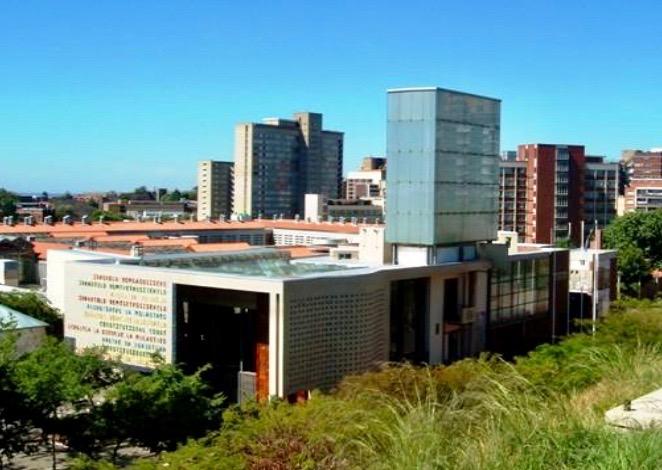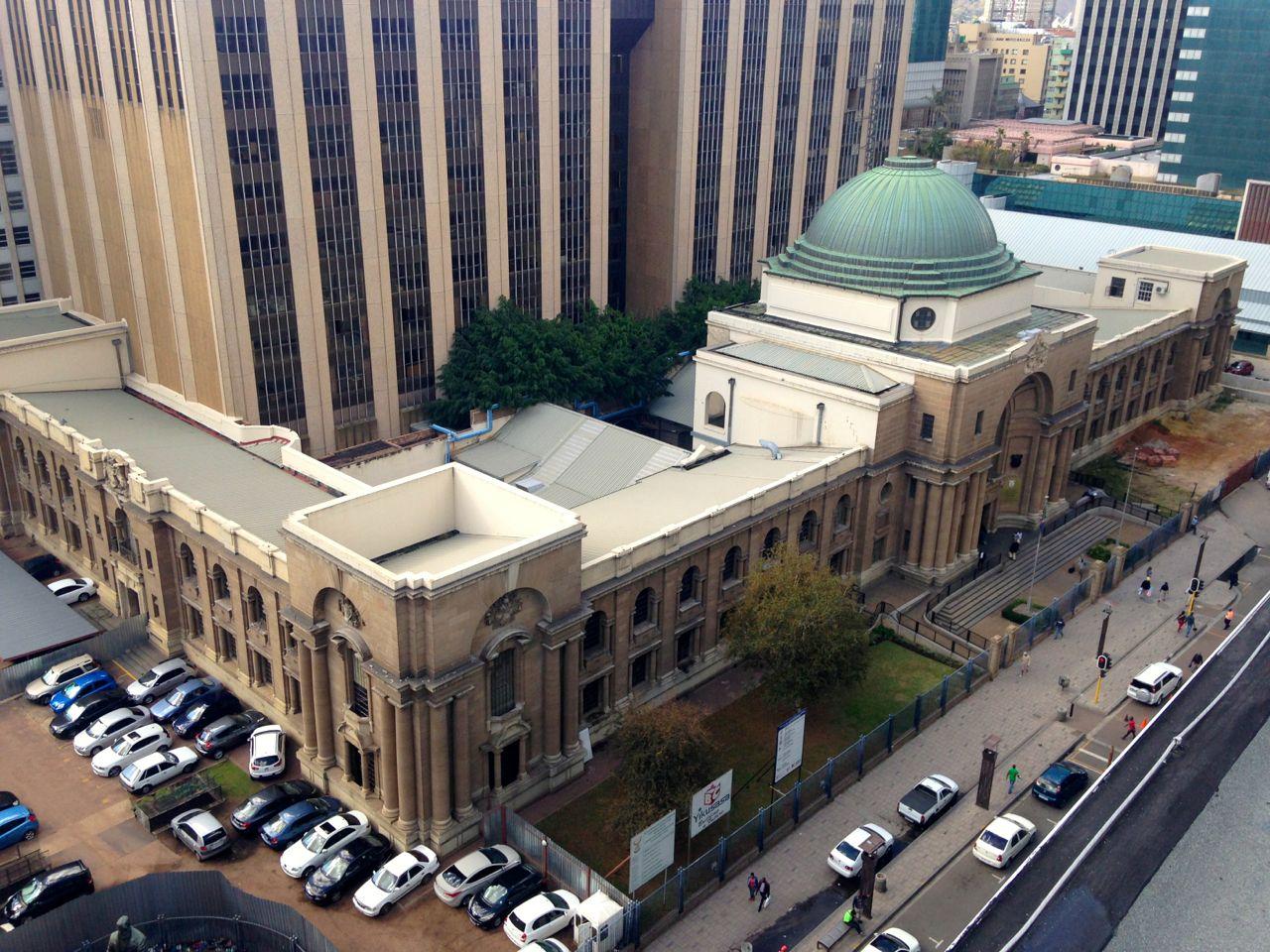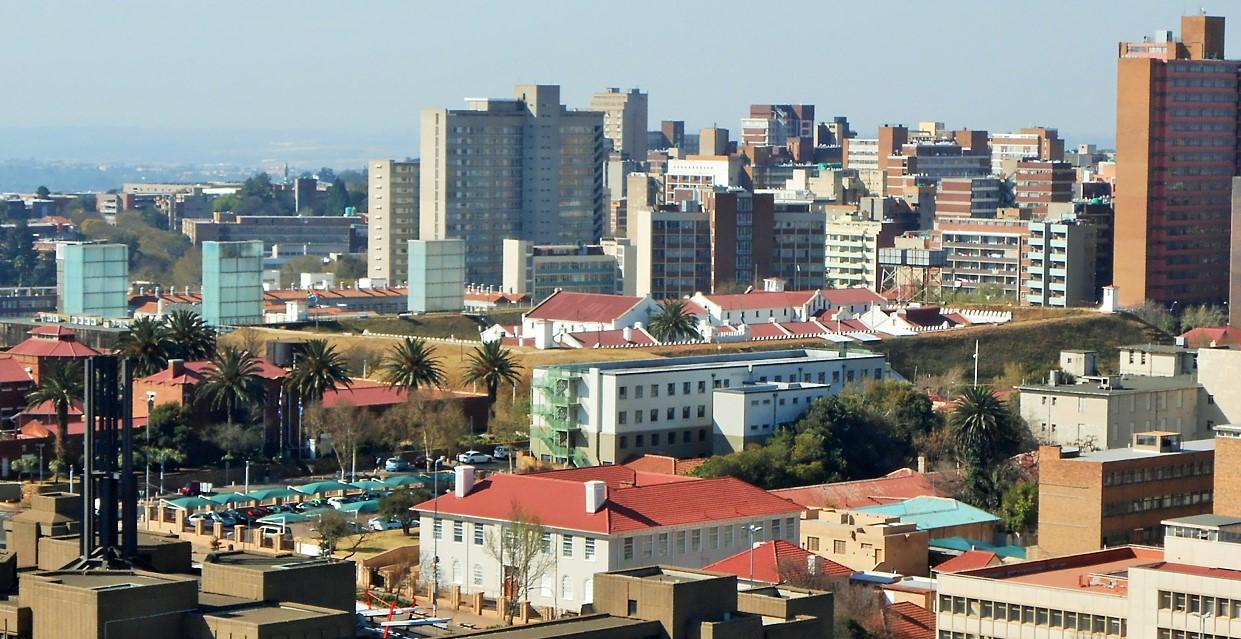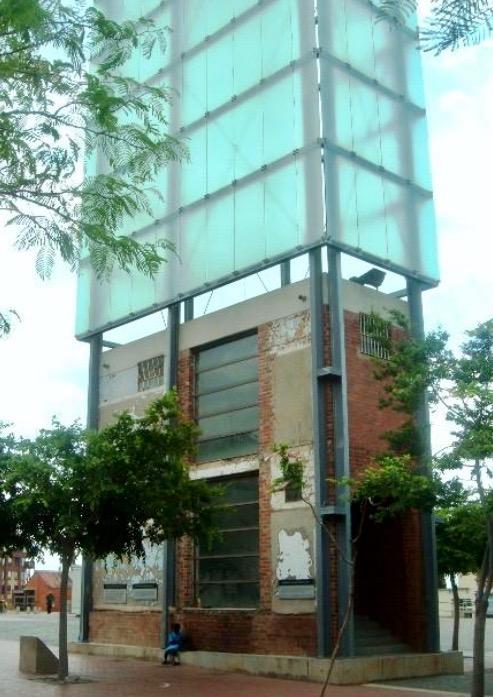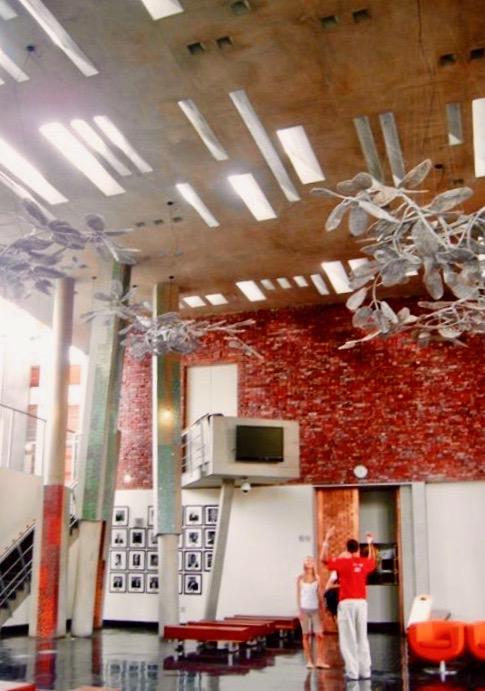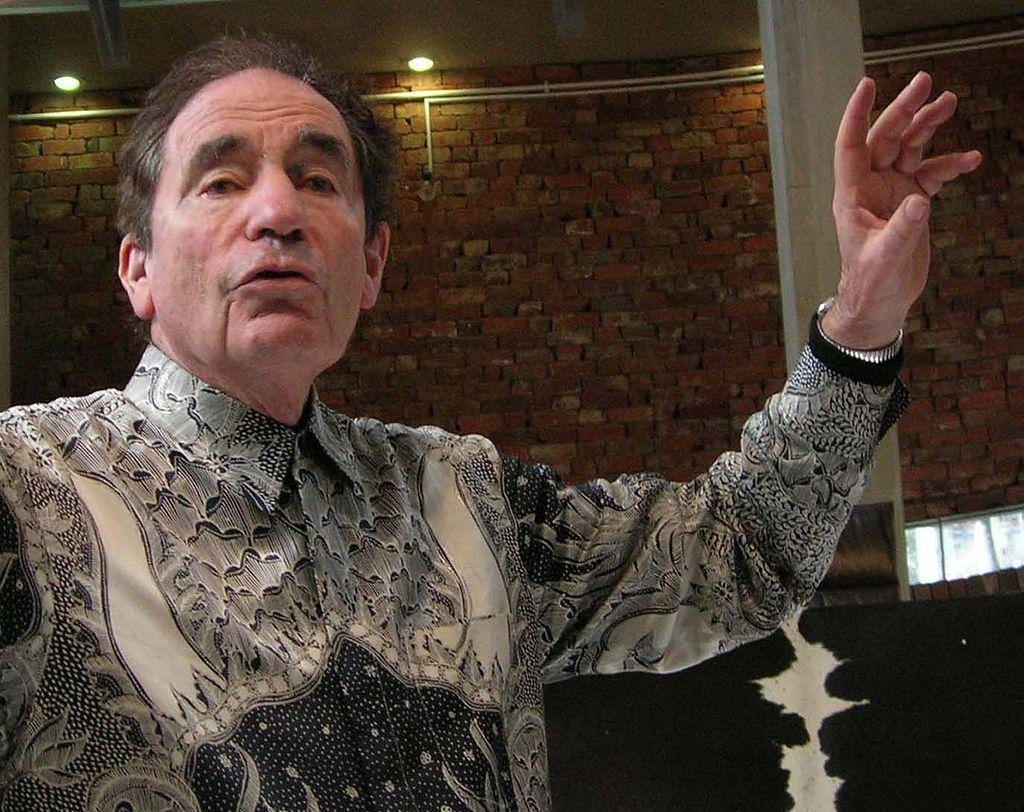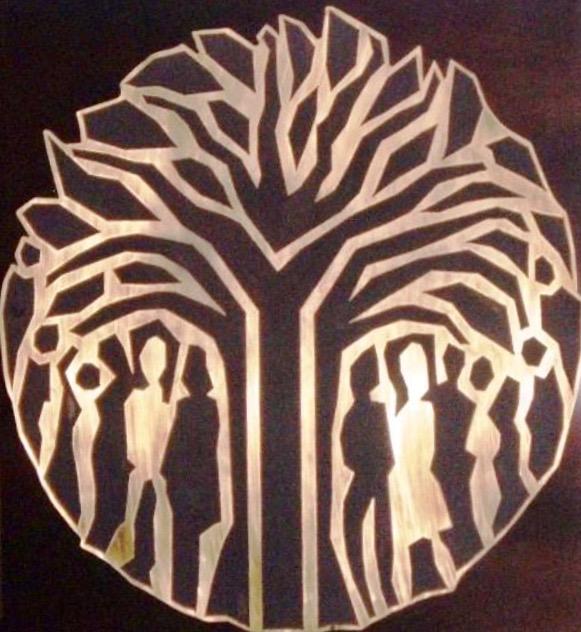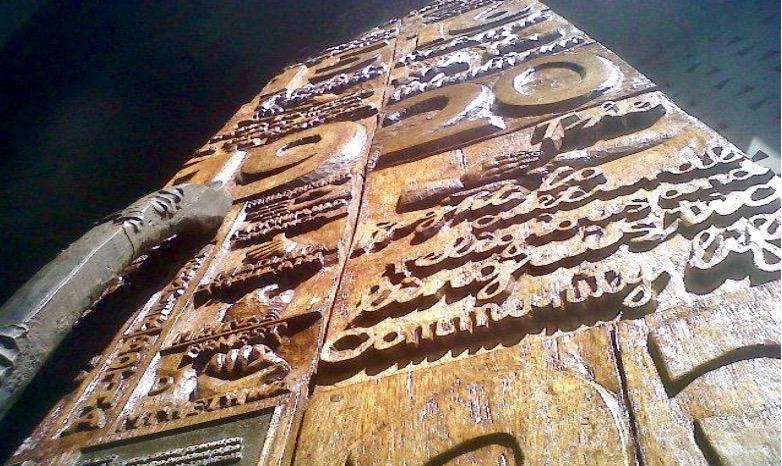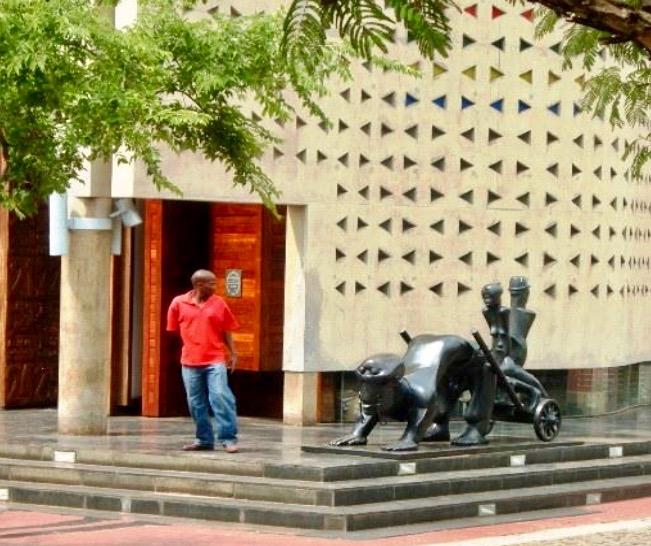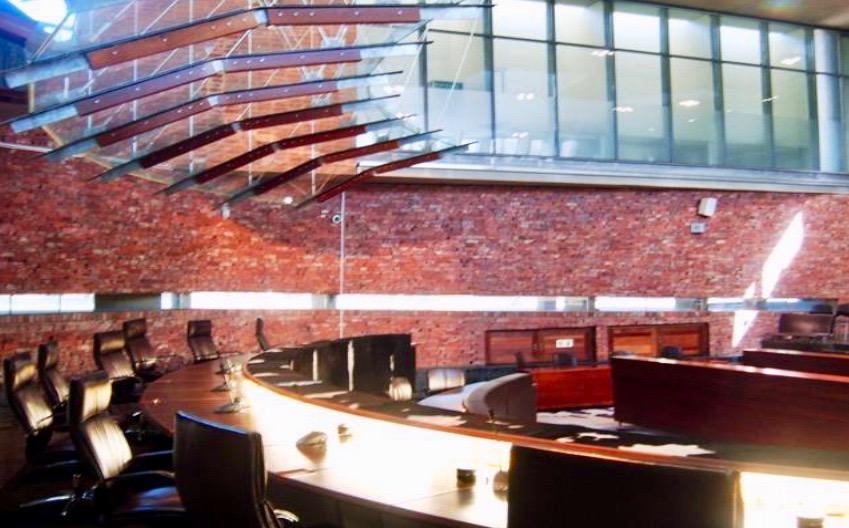
Disclaimer: Any views expressed by individuals and organisations are their own and do not in any way represent the views of The Heritage Portal. If you find any mistakes or historical inaccuracies, please contact the editor.
In the remarkable article below, journalist Lucille Davie describes her tour of the Consitutional Court with Justice Albie Sachs. She delves into the history, art and architectiure of a hugely significant site. The piece first appeared on the City of Joburg's website on 6 August 2004. Click here to view more of Davie's work.
The invitation said: "Join a tour of the Constitutional Court at 5.30pm on Friday, conducted by Justice Albie Sachs." I didn't hesitate for a moment and discovered that it was as much a tour of the court as a tour as Sachs's life and passions.
Sachs says he was appointed, together with fellow judge Yvonne Mokgoro, to take charge of decor when the Constitutional Court came into being in 1994 at its old location in Braampark in Braamfontein, just across the road from its present position. Not a job most employees would relish, but Sachs gathered it up with gusto.
What the job essentially means is that he gets to badger artists into donating the court an artwork or two - although most seem to have given willingly. Who wouldn't, after all, give an artwork to be displayed in the highest court in the land, in one of the most exciting buildings to be built in the city in the past year or so?
Constitutional Court from the ramparts of the Old Fort (The Heritage Portal)
Besides, Sachs is eloquent, worldly, quietly charming, very smart, and obviously, very persuasive, as the collection of 200 works - oils, etchings, tapestries, wire works, carvings - shows. A good slice of South African artists are represented: Norman Catherine, Bongi Dhlomo, Gerard Sekoto, William Kentridge, Nhlanhla Xaba, Diane Victor, Robert Hodgins, Kim Berman, Sipho Ndlovu, Cecil Skotnes . . .
The building
Sachs starts the tour talking about the building as architecture. It could have had, he says, tall, Roman columns and a woman carrying the scales of justice, but these traditional symbols were emblematic of "dead white male judges", and "just jarred". After the long fight for our constitution, these didn't seem vaguely appropriate, he says.
The more traditional design of the South Gauteng High Court (The Heritage Portal)
Rather, a building that became the most notorious prison in the country, the Old Fort and "native" jail, captured a lot of what the struggle was about, and so was chosen as the perfect location. The awaiting trial building had to be demolished (although four stairwells were preserved, to be made into landmark towers), but the most significant building, the prison known as No 4, was left untouched, and now stands as a newly-healed sore, still rough with scar tissue but a powerful statement.
The Old Fort from above. To the left you can see the landmark towers (The Heritage Portal)
Stairwell with landmark tower (The Heritage Portal)
This is where some of apartheid's most sadistic prison officers imposed their warped minds on blacks brought in for petty offences like failing to carry their pass books. They were made to line up naked, jump up in the air several times, and, on landing, bend over to have their rectums inspected for smuggled items.
No 4 still looks largely like it did back then, running down the hill that is the northern face of the Hillbrow ridge, with a row of solitary confinement cells at the bottom of the complex, and tarred courtyards lending structure to the rectangle of cells around its edges, cells where men slept on the floor, in rows, elbows touching.
The stone eastern wall of No 4 - "the beautiful, terrible wall of No 4" - backs on to the Great African Steps, the outdoor walkway up to the Constitutional Court.
The court building itself Sachs describes as welcoming, a place where people "should feel safe, secure and welcome".
He goes on: "Most court buildings are very intimidating, they make you feel guilty." Instead, this "spartan" building with its creative finishes, he says, is made of eight materials: "Concrete, stone, steel, glass, timber, light, imagination and love."
Sachs describes the triple-volume foyer, with its angled, mosaic-covered tree-like pillars and wire blossom lights suspended from the roof, as "a clearing in the forest where sun shines in, and moves over the day, still shining in. In touch with the natural world around us."
The triple volume foyer (The Heritage Portal)
Large, open galleries rather than passageways, are also filled with natural elements: fish traps for lights, reed roofing evocative of huts, wooden slated ceilings and walkways, with 11 creative ventilation chimneys, each done by people from the 11 provinces. Between the judges' chambers are smooth, square ponds surrounded by indigenous coral trees and cycads.
"The building is open, transparent, natural and beautiful," says Sachs.
And funky . . . At the bottom of the stepped gallery, hanging in the air, are colourful outlines of the 11 provinces, done by Andrew Verster. Sachs delights in the description, saying he knows of no other court in the world that people describe as "funky".
Distinguished fighter
Sachs is a distinguished fighter for human rights in South Africa, having almost given his life to the struggle in Maputo, Mozambique, in 1988 where he was the victim of a car bomb and lost most of his right arm and the sight of one eye. He is also distinguished as a lawyer, having taught law at Columbia University in New York, at the University of London, at the University of Cape Town, and Eduardo Mondlane University in Maputo.
Justice Albie Sachs at the Constitutional Court (Ram Eisenberg via Wikipedia)
He's written many books on human rights, and has been awarded honorary doctorates of law by the universities of Southampton, York in Toronto, Antwerp in Belgium, London and the William Mitchell College of Law in Minnesota.
He was detained without trial for 168 days, and in 1966 went into exile, returning to South Africa in 1990. He spent time in solitary confinement, and later wrote The Jail Diary of Albie Sachs, followed by The Soft Vengeance of a Freedom Fighter, detailing his recovery from the car bomb.
He has close links with the constitution, having been active in the negotiations for a new constitution as a member of the Constitutional Committee of the ANC and the National Executive, back in 1993, and then later, helping to draw up the interim constitution.
Art has been a passion all his life, but he does not have a big collection as, on his return to South Africa from exile, he gave his collection to the Mayibuye Centre at the University of the Western Cape.
So, really, he's qualified to talk about the Constitutional Court, and equally qualified to create this art gallery. In another life, I suspect he might have been an architect, or an artist, such is his enthusiasm.
Logo
Sachs talks about the court's logo, a tree with a crowd of people beneath its branches. It was quite a process to decide on the logo, he says. After some discussion with his 11 fellow judges, judge Kate O'Regan said she knew someone in Cape Town who "might just be right" for the final image. Sachs went to see her and "I knew she was the right person".
Until then it had been a choice between the tree and the people. Now it became one concept - a crowd of people standing beneath the tree, in black and white, encapsulated in a circle.
"The tree protects the people, and they look after the tree. Besides, in South Africa justice has traditionally taken place under a tree," explains Sachs.
So there it was - a simple concept, a perfect solution.
The Constitutional Court Logo (The Heritage Portal)
Artworks
Standing outside the court's huge wooden doors, Sachs explains the cursive writing that appears in concrete high above the door. Each judge has written in his or her mother tongue the words: equality, dignity and freedom.
"The one up there that looks like a nine-year-old child's writing, that's mine," he says, with a smile, recollecting how he felt like a primary school child who had to learn to write again, with his left hand, after losing his right arm.
The impressive 8m wooden doors have a history too. The judges asked for wood but the architects said they preferred metal as wood was not durable. The judges replied: look at the great wooden doors in cathedrals in Europe, they're centuries old and still looking good. It was a persuasive argument, and so the spectacular doors are wood, carved by craftspeople in Durban, depicting the 27 themes of the Bill of Rights, in sign language.
The magnificent doors (The Heritage Portal)
But it's the detail that Sachs and his fellow judges have given their attention to that really amazes: the tiles, carpets, lights, sunshades, even the brass step edging . . .
Most of these projects were completed by means of competitions. Instead of discarding entries that didn't make it, the judges and the artworks committee, headed by the architect Janina Masojada, took note of details of the works, and asked for them to be made into colourful carpets or wall hangings.
The great thing about Sachs' tour of the artworks is that he knows, and knew, some of the artists personally, so that he can give personal anecdotes about them.
Dumile Feni
He describes Dumile Feni, an artist he knew for 23 years, in exile in London and New York, as a "close, close friend". One evening in 1969 Feni visited him in London and stood and sketched a figure, giving it to Sachs, ostensibly to pay for meals Sachs had shared with him. It now has a place among 14 other works by the artist in the gallery.
"What was special about him", says Sachs, "was that, at a time when artists connected with the struggle were painting bodies being carried away, and fists and spears, and denunciations of the cruelty of the regime, Dumile was concentrating on the dignity of the people, their tenderness, their humanity. And, in a sense, he prefigured our whole constitutional order, what our Bill of Rights is about."
Sachs tells the story with passion; I looked around and a big, burly fellow had tears in his eyes.
Dumile Feni sculpture outside the Constitutional Court (The Heritage Portal)
The blue dress
Sachs points to a blue plastic dress on a hanger, high up in the gallery space. It's the creation of Judith Mason, entitled 'The Blue Dress', and it came about when she was listening to the Truth and Reconciliation Commission hearings on the radio. She heard about the description of a shallow grave containing a naked woman with a piece of plastic covering her private parts. The policeman who shot her in the head described how brave she had been - she had asked if she could kneel and sing Nkosi Sikelele before she was executed.
Mason rushed out and found several blue plastic bags and stitched them together to make a dress. A painting followed, and Sachs, after seeing it, asked the artist to temper the snarling beast looking menacingly at the floating dress. Mason produced a second painting, with a row of blazing braziers in the foreground, offering warmth and hope.
Sachs's initial budget for purchasing art for the court was R10 000. This was spent on one work, Joseph Ndlovu's 'Huddle', a tapestry, and Sachs donated several artworks to the gallery from his own collection. That R10 000 has become a collection that must be worth millions now.
Lucille Davie has for many years written about Jozi people and places, as well as the city's history and heritage. Take a look at lucilledavie.co.za
Comments will load below. If for any reason none appear click here for some troubleshooting tips. If you would like to post a comment and need instructions click here.

